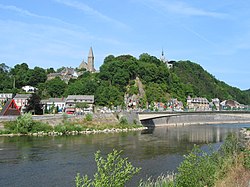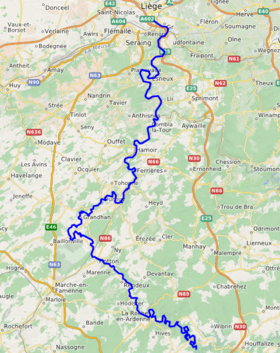Ourthe
| Ourthe | |
|---|---|
 | |
 Course of the Ourthe | |
| Location | |
| Country | Belgium |
| Physical characteristics | |
| Source | |
| • location | Confluence of the Ourthe Occidentale and the Ourthe Orientale |
| • coordinates | 50°08′01″N 5°40′41″E / 50.1335°N 5.6781°E |
| Mouth | |
• location | Meuse |
• coordinates | 50°37′22″N 5°34′49″E / 50.6228°N 5.5802°E |
| Basin features | |
| Progression | Meuse→ North Sea |
| Tributaries | |
| • right | Amblève, Vesdre |
The Ourthe (French pronunciation: [uʁt]; Walloon: Aiwe d' Oûte) is a 165-kilometre (103 mi) long river in the Ardennes in Wallonia (Belgium). It is a right tributary to the river Meuse. The Ourthe is formed at the confluence of the Ourthe Occidentale (Western Ourthe) and the Ourthe Orientale (Eastern Ourthe), west of Houffalize.
The source of the Ourthe Occidentale is near Libramont-Chevigny, in the Belgian province Luxembourg. The source of the Ourthe Orientale is near Gouvy, also in the Belgian province Luxembourg, close to the border with Luxembourg.
After the confluence of the two Ourthes at Lake Nisramont, the Ourthe flows roughly in north-west and later in northern direction. Near Noiseux it flows for a short distance through the province of Namur. After the municipality of Durbuy it flows into Liège Province. Eventually it flows into the river Meuse in the city of Liège. The most important tributaries of the river Ourthe are the Amblève and the Vesdre. Towns along the Ourthe are Houffalize (Ourthe Orientale), La Roche-en-Ardenne, Hotton, Durbuy, Hamoir and Esneux.
Near Hotton, the caves of Hotton are located. In these caves runs a subterranean river which flows in the Ourthe.
Near Esneux lies the Roche aux Faucons. This is a vantage point located on a high cliff, above a meander of the Ourthe. In the south, near Marcourt, there is another high cliff where the Hermitage and chapel of Saint-Thibaut is located.
Around 1820, William I of the Netherlands demanded the creation of the Ourthe channel. Via the Ourthe, this channel would have connected the Meuse basin with the Moselle basin. Belgium's independence in 1830 put an end to these plans. The main remnant of these works is the unfinished channel tunnel in Bernistap (province of Luxembourg).
Text is available under the CC BY-SA 4.0 license; additional terms may apply.
Images, videos and audio are available under their respective licenses.












